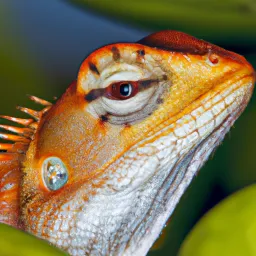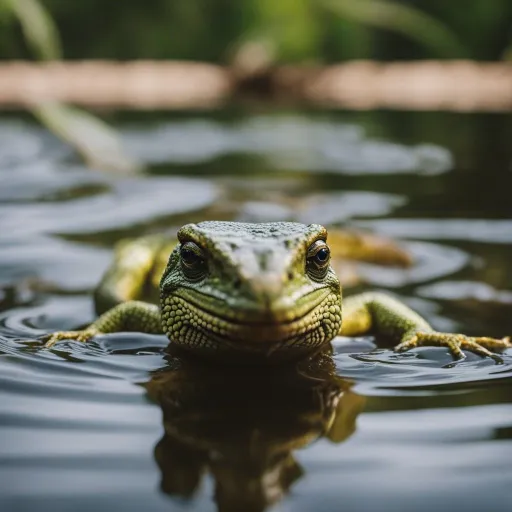So, you’ve always wondered if lizards have lips, haven’t you? We often associate lips with mammals and humans, but what about these scaly creatures?
In this article, we’ll explore the fascinating world of lizards and answer the burning question: do lizards have lips?
Get ready to uncover the hidden secrets of these reptiles and learn more about their unique features.
Physical Characteristics of Lizards
Lizards are a diverse group of reptiles that exhibit a wide range of physical characteristics.
One of the most notable features of lizards is their scales, which cover their entire body and provide a protective barrier.
These scales serve various purposes, including reducing water loss, providing camouflage, and offering defense against predators.
In addition to scales, lizards also have unique skin that helps them regulate their body temperature.
Unlike mammals, lizards lack sweat glands and rely on their skin to absorb heat from the environment. This allows them to effectively thermoregulate and thrive in different climates.
Another fascinating physical characteristic of lizards is their tongue. Lizards have long, slender tongues that are often forked at the end. This forked tongue plays a crucial role in their sensory perception. It allows them to gather information about their surroundings by picking up scent particles in the air. The forked nature of the tongue enables lizards to accurately determine the direction and proximity of potential prey or predators.
When it comes to eyes, lizards have a variety of eye shapes and sizes depending on their species. Their eyes are well adapted for different environmental conditions and hunting strategies. Some lizards, such as geckos, possess large, bulging eyes that provide them with excellent vision, especially in low-light environments. Others, like chameleons, have independently moving eyes that allow them to simultaneously scan for predators in all directions. This unique eye structure gives them a 360-degree field of vision, making it difficult for predators to sneak up unnoticed.
While not all lizards have teeth, many do possess specialized dentition. The teeth of lizards are sharp and pointed, designed to grip and tear apart their prey. The size and shape of their teeth may differ depending on their dietary preferences. For instance, carnivorous lizards tend to have longer, more pointed teeth, while herbivorous lizards have blunter teeth for grinding plant material. Teeth are essential for lizards to consume and process their food effectively, playing a vital role in their digestion.
Lip Structure in Reptiles
Although lips may not be as prominent in reptiles as they are in mammals, they still serve important functions. Lips in reptiles, including lizards, play a crucial role in various aspects of their lives, from food capture to communication. While the physical appearance and structure of lips may differ across reptile species, they all share certain common characteristics and functions.
The importance of lips in reptiles lies in their ability to control and manipulate the food they consume. Lips aid in capturing and holding prey items, preventing them from escaping. In addition, lips provide a barrier between the mouth and the external environment, protecting the delicate tissues within the oral cavity. They also play a role in preventing food from spilling out while the lizard chews and swallows.
Different reptile species possess varying lip structures that are adapted to their specific feeding strategies and habitats. For example, aquatic reptiles, such as turtles and alligators, have robust, fleshy lips that aid in capturing and manipulating slippery prey in aquatic environments. On the other hand, terrestrial lizards may have thinner, more flexible lips that enhance their ability to catch and hold onto terrestrial prey.
The evolution of lips in reptiles is an interesting topic of study. Lips likely developed as an adaptation to facilitate more efficient feeding. The emergence of lips allowed reptiles to better control and manipulate their food, providing them with a competitive advantage. Over time, lips have diversified and undergone modifications to suit the specific needs of different reptile species.

Anatomy of Lizard Lips
Lips, in general, are defined as soft, movable structures that form the boundaries of the mouth. In lizards, the anatomy of their lips can vary depending on their species and ecological niche. Lizard lips are composed of layers of skin and contain numerous blood vessels and nerve endings, giving them both physical and sensory functions.
In terms of appearance, lizard lips are typically thin and flexible. They are often covered in scales like the rest of the lizard’s body, although the scales on the lips may be smaller and more delicate. The coloration of lizard lips can vary, ranging from dull shades to vibrant hues, depending on the species. In some cases, the lips may even exhibit patterns or markings that aid in species recognition or camouflage.
Lizard lips serve several important functions. First and foremost, they help in the capture and manipulation of food. The lips act as a barrier to keep prey items inside the mouth, preventing them from escaping. They also aid in guiding food towards the teeth for efficient chewing and swallowing. In addition, lizard lips contribute to the overall protection of the oral cavity, shielding the delicate tissues from mechanical damage during feeding.
Do Lizards Have Visible Lips?
When it comes to the visibility of lips in lizards, there is variation among species. Some lizards have more visible lips, while others may have lips that are less distinct or even completely absent. The presence or absence of visible lips is influenced by various factors, including the lizard’s diet, feeding strategy, and habitat.
In certain lizard species, the lips may be readily noticeable, especially in those that primarily consume larger prey items. These lizards often require more precise control over their food, and visible lips aid in capturing and manipulating their prey efficiently. On the other hand, lizards that primarily feed on smaller prey or utilize suction feeding techniques may have less prominent lips, as they rely more on rapid mouth opening and suction to capture their food.
In some cases, lips may be absent altogether in certain lizard species. This absence is often associated with specialized feeding adaptations. For example, some burrowing lizards have reduced or even absent lips to facilitate efficient digging and prevent the ingestion of soil or sand particles. These lizards have developed alternative mechanisms, such as protrusible tongues or specialized snouts, to aid in capturing their underground prey.
The presence or absence of scales on the lips can also impact lip visibility. If the scales on the lips are small and closely resemble the surrounding skin, the lips may appear less distinct. Conversely, if the scales on the lips are more prominent or exhibit unique patterns, the lips may be more noticeable.

Lip Adaptations in Lizards
Lizard lips have evolved various adaptations that enable them to thrive in different environments and fulfill specific functions. These adaptations can be categorized into three main groups: lips for food capture, lips for communication, and lips for environmental adaptations.
Lips adapted for food capture are typically seen in lizards that rely on precise manipulation of their prey. These lips are often well-developed and can range from fleshy, muscular structures to thin, flexible membranes. They assist in grabbing and holding onto prey, providing the lizard with greater control during feeding. Additionally, specialized lip structures, such as serrations or small ridges, may aid in gripping slippery or wiggling prey.
Lips in lizards can also serve as a means of communication. Some species have brightly colored or patterned lips that play a role in mate selection or territorial displays. The vibrant colors or distinct markings on the lips may attract potential mates or act as a warning signal to rival males. The ability to exhibit and differentiate lip colors or patterns enhances the lizard’s ability to communicate and assert its dominance within its social group.
In certain environments, such as deserts or arid regions, lizards have evolved lips that are adapted to cope with the harsh conditions. These specialized lips help reduce water loss by minimizing the exposure of the lizard’s mouth to the dry air. The lips may have thicker, more keratinized skin or even unique structural features that create a seal when the mouth is closed. These adaptations support the lizard’s survival in arid climates by conserving precious moisture.
Sensory Receptors in Lizard Lips
Lizard lips are not only involved in physical functions but also possess sensory capabilities. The presence of sensory receptors in lizard lips allows them to gather important information about their environment and aids in various behaviors, including foraging and social interactions.
Tactile sensitivity is one of the sensory functions exhibited by lizard lips. Specialized sensory receptors, such as mechanoreceptors, are present in the lips and provide feedback on the texture, shape, and movement of objects. This tactile information helps lizards determine the quality and suitability of potential prey items or environmental conditions. The lips act as sensitive touch organs, allowing lizards to make precise judgments when interacting with their surroundings.
Thermoreception, or the ability to detect heat, is another sensory function associated with lizard lips. The presence of thermoreceptors in the lips enables lizards to detect and respond to temperature changes in their environment. This is especially important for ectothermic reptiles like lizards, as they rely on external heat sources to regulate their body temperature. By sensing variations in temperature, lizards can adjust their behavior and position themselves optimally for thermoregulation.
Chemoreception, the sensing of chemical stimuli, is another capability of lizard lips. The forked nature of their tongues allows lizards to gather scent particles from the air, but the chemosensory abilities extend to their lips as well. Lips contain chemoreceptors that can detect and discriminate certain chemicals, aiding in prey detection, territorial marking, or mate selection. The lips act as an additional olfactory organ, enhancing the lizard’s ability to perceive and respond to chemical cues in its environment.

Lip Movements in Lizards
Lizard lips are not static structures but can exhibit various movements that serve important functions in their lives. These movements are diverse and can differ depending on the species, feeding behavior, or social interactions involved.
Different types of lip movements can be observed in lizards. For instance, protraction and retraction of the lips are common during feeding. When capturing prey, lizards extend their lips forward to engulf the prey item and then retract them to secure the prey within the mouth. This movement ensures that the prey remains within the lizard’s grasp during chewing and swallowing.
Lip movements also play a significant role in social interactions among lizards. Certain species display lip movements as part of their visual displays during courtship or territorial disputes. These movements may involve rapid flicking or deliberate opening and closing of the lips. The lip movements, combined with other behavioral cues, communicate the lizard’s intentions and establish dominance or courtship rituals within their social group.
Lips in Different Lizard Families
Lizards encompass a vast array of species, each belonging to various families. While there are numerous lizard families, we will focus on a few examples to illustrate the diversity of lip structures and functions across different groups.
Iguanas
Iguanas, part of the family Iguanidae, are known for their herbivorous feeding habits. Their lips are generally thin and flexible, allowing them to delicately grasp and manipulate plant material. The lips in iguanas have adapted to facilitate efficient browsing and grinding of vegetation, enabling them to extract nutrients from their herbaceous diet.
Geckos
Geckos, belonging to the family Gekkonidae, exhibit a wide range of lip structures depending on their ecological niche and feeding behavior. Some gecko species have fleshy, well-developed lips that aid in capturing and swallowing prey, while others have thinner, less visible lips suited for specialized feeding strategies like consuming nectar or insect eggs.
Chameleons
Chameleons, part of the family Chamaeleonidae, are famous for their unique ability to change color and their distinctive head crests. In many chameleon species, the lips are highly mobile and contribute to their specialized feeding behavior. The lips, along with the independently moving eyes, allow chameleons to accurately aim and project their long, sticky tongues towards prey, ensuring a successful capture.
Skinks
Skinks, belonging to the family Scincidae, encompass a diverse group of lizards found worldwide. Many skink species have well-developed lips that aid in capturing small invertebrates. The lips of skinks have specialized structures, such as ridges or serrations, that assist in gripping and preventing prey from escaping during feeding.
Lip Loss or Reduction in Lizards
While many lizard species possess well-defined lips, there are cases where lips have been reduced or lost altogether as a result of evolutionary adaptation. These reductions in lip structures can be seen in lizards that have undergone specialized adaptations to specific environments or feeding strategies.
Evolutionary changes have led to lip reduction or loss in lizards living in dry environments. Desert-dwelling lizards often encounter sandy or rocky substrates and have evolved adaptations that enable them to cope with these conditions. To prevent the ingestion of sand particles while foraging, some desert lizards have reduced or absent lips. In these cases, other specialized adaptations, such as the presence of shovel-like snouts or specialized tongues, have evolved to compensate for the loss of lip functionality.
Burrowing lizards also exhibit reduced or absent lips as an adaptation to their subterranean lifestyle. Lips can hinder efficient digging and may collect soil or sand particles, leading to difficulty in resurfacing. By reducing or eliminating their lips, burrowing lizards can navigate underground environments more efficiently and prevent the ingestion of debris while feeding.
Examples of lipless lizards include various species of worm lizards (Family Amphisbaenidae), which have elongated, cylindrical bodies adapted for burrowing. These lizard-like reptiles lack visible lips, possessing a specialized jaw anatomy that aids in capturing and swallowing prey while underground.
Final Thoughts
In conclusion, while lips may not be the most prominent feature in lizards, they play crucial roles in their feeding, communication, and adaptation to different environments.
Lizard lips are diverse in their appearance and function, reflecting the remarkable evolution and diversity within the reptile world.
From gripping and manipulating food to conveying social signals, the lips of lizards are multifaceted structures that contribute to their survival and success in various habitats.
So, the next time you observe a lizard, take a closer look at its lips, and marvel at the intricate adaptations that enable these fascinating creatures to thrive.




